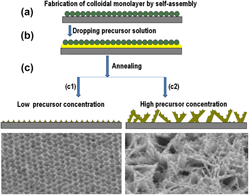Crossref Citations
This article has been cited by the following publications. This list is generated based on data provided by
Crossref.
Khan, Mohammad Mansoob
Ansari, Sajid Ali
Khan, Mohammad Ehtisham
Ansari, Mohd Omaish
Min, Bong-Ki
and
Cho, Moo Hwan
2015.
Visible light-induced enhanced photoelectrochemical and photocatalytic studies of gold decorated SnO2nanostructures.
New Journal of Chemistry,
Vol. 39,
Issue. 4,
p.
2758.
Zhong, Xin
Dai, Zan
Qin, Fan
Li, Ju
Yang, Hao
Lu, Zhong
Liang, Ying
and
Chen, Rong
2015.
Ag-decorated Bi2O3 nanospheres with enhanced visible-light-driven photocatalytic activities for water treatment.
RSC Advances,
Vol. 5,
Issue. 85,
p.
69312.
Zhai, Y. J.
Li, J. H.
Chu, X. Y.
Xu, M. Z.
Li, X.
Fang, X.
Wei, Z. P.
and
Wang, X. H.
2015.
Photocatalytic Performance in Oxide Nanomaterials.
Integrated Ferroelectrics,
Vol. 167,
Issue. 1,
p.
1.
Shi, Jinwen
Guo, Penghui
Liu, Ya
Su, Jinzhan
and
Guo, Liejin
2016.
PbO-sensitized ZnO nanorod arrays for enhanced visible-light-driven photoelectrochemical performance.
Journal of Materials Research,
Vol. 31,
Issue. 11,
p.
1622.
Hoshyargar, Faegheh
Mahajan, Manika
Anuradha
Bhosale, Sheshanath V.
Kyratzis, Louis
Bhatt, Anand I.
and
O'Mullane, Anthony P.
2016.
Superhydrophobic Fabrics for Oil/Water Separation Based on the Metal–Organic Charge‐Transfer Complex CuTCNAQ.
ChemPlusChem,
Vol. 81,
Issue. 4,
p.
378.
Chen, Qi
Rogachev, A.V.
Yarmolenko, M.A.
Rogachev, A.A.
Jiang, Xiaohong
and
Gorbache, D.L.
2017.
Peculiarities of Electron-Beam Formation of Hydrophobic and Superhydrophobic Coatings Based on Hydrocarbons of Various Molecular Weights and PTFE.
Journal of Coating Science and Technology,
Vol. 4,
Issue. 1,
p.
21.
Agrawal, Nikhil
Munjal, Sandeep
Ansari, Mohd Zubair
and
Khare, Neeraj
2017.
Superhydrophobic palmitic acid modified ZnO nanoparticles.
Ceramics International,
Vol. 43,
Issue. 16,
p.
14271.
Osotsi, Maurice I.
Macharia, Daniel K.
Zhu, Bo
Wang, Zhaojie
Shen, Xiaofeng
Liu, Zixiao
Zhang, Lisha
and
Chen, Zhigang
2018.
Synthesis of ZnWO4−x nanorods with oxygen vacancy for efficient photocatalytic degradation of tetracycline.
Progress in Natural Science: Materials International,
Vol. 28,
Issue. 4,
p.
408.
Wu, Shuisheng
Wang, Ran
Tan, Nianyuan
Lan, Donghui
Au, Chak-Tong
and
Yi, Bing
2018.
Spray-assisted vapor deposition of CdS nanoparticles on ZnO nanowires with enhanced photocatalytic performance.
Materials Research Express,
Vol. 5,
Issue. 12,
p.
125009.
Liang, Baoyan
Zhang, Wangxi
Zhang, Yanli
Zhang, Ruijie
and
Liu, Ying
2018.
Efficient visible-light photocatalyst synthesized by modifying SnO with activated carbon.
Materials Research Express,
Vol. 6,
Issue. 1,
p.
015603.
Sabry, Raad Saadon
and
Fahad, Nisreen Khalid
2019.
Oleic acid-modified superhydrophobic ZnO nanostructures via double hydrothermal method.
Journal of Adhesion Science and Technology,
Vol. 33,
Issue. 14,
p.
1558.
